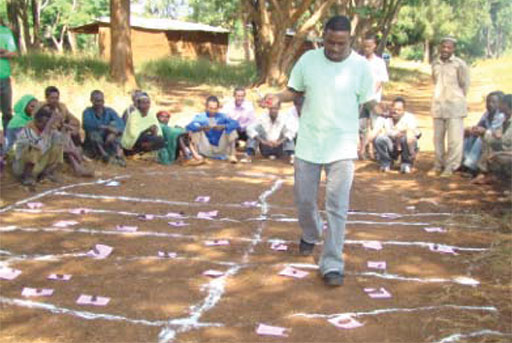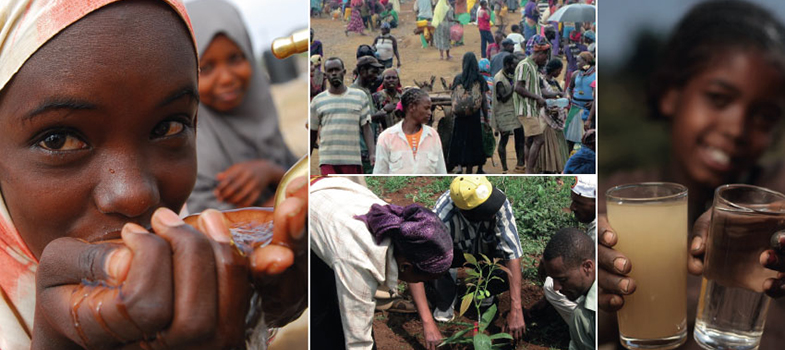5.2.1 Community-Led Total Sanitation and Hygiene
Ethiopia has adopted Community-Led Total Sanitation and Hygiene (CLTSH) as a national tool to promote total sanitation. It aims to change the behaviour of everyone in a community to stop open defecation and encourage good hygiene practices. The goal is to achieve Open Defecation Free (ODF) status for the community where everyone has access to a latrine and no one defecates in the open at any time. The Federal Ministry of Health has published guidelines for implementing CLTSH. The process, outlined in Box 5.1, should be conducted by trained facilitators.
Box 5.1 CLTSH process
There are three main stages in CLTSH: pre-triggering, triggering and post-triggering (Kar and Chambers, 2008; FMOH, 2012).
Pre-triggering stage
At this stage, community representatives and the CLTSH facilitator discuss and agree a convenient time and place for village triggering and make plans for the whole process.
Triggering stage
The whole community gathers to discuss concerns relating to open defecation (OD). Together, the facilitators and community members make a transect walk. A transect walk entails walking through a village from one side to the other, observing, asking questions, and listening to the replies (Kar and Chambers, 2008). The purpose is to identify sites used for OD, hence the alternative name of shame walk, and to note the locations, types and conditions of any existing sanitation facilities.
Then the facilitators and community together prepare a map of the local area showing households, institutions and OD sites and helps everyone to understand the scale of the OD problem and the associated health risks (Figure 5.3). With the facilitators, they calculate how much human excreta they produce, known as ‘the shit calculation’. Triggering refers to the moment, also known as the ‘ignition moment’, when the whole community shares a sense of disgust and shame about open defecation. The facilitator helps them to come to the realisation that they quite literally will be eating one another’s faeces if open defecation continues.
The end of the triggering phase is agreement on actions to be taken. The action plan should have an agreed schedule and set of activities that everyone in the community commits to, including the construction of latrines with handwashing facilities and a commitment from everyone that they will use the new facilities at all times. A CLTSH committee of community representatives should be formed to take the process forward.
Post-triggering stage, including verification
The post-triggering stage is when the agreed plan is put into effect. The community may need additional support and training for construction of new facilities and for behaviour change in sanitation and hygiene practices. In this phase, a supervisory team will be formed to conduct routine monitoring and evaluation. They monitor the changes through review meetings, periodic reports, observations and interviews.
Verification is the stage when the village is assessed to find out if everyone is now using a latrine and washing their hands. Confirmation that open defecation has stopped and the certification of ODF status is a cause for celebration for the whole community.

In the CLTSH process, all households (men, women and children) and institutions (religious and social institutions) in a village should be included. However, to be truly inclusive it is essential that all members of the community are full participants, including people with disabilities and other marginalised groups (House et al, 2017). Although not specified in the FMoH guidelines, the process should go beyond general community participation and ensure that every group in the community is fairly represented and able to participate from the start.
For each of the three stages of CLTSH, can you suggest ways the process could be made more inclusive?
You may have thought of the following:
- Pre-triggering: (i) Include a deliberate step of considering the needs of different people in the community and agree on how to engage everyone in the whole process. (ii) Discuss the subject with women of different ages separately, without men present, to see if they have specific concerns about safety and privacy, and to find out their perspective.
- Triggering stage: (i) Transect walks, mapping and other activities must involve representatives of the whole community including persons with disabilities (that is, physical, intellectual and sensory impairments), elderly people (men and women), pregnant women, women and adolescent girls, children, and people with long-term sickness. (ii) Action plans must incorporate the different needs of all marginalised groups. (iii) The CLTSH committee should include persons with disabilities as members.
- Post-triggering: Persons with disabilities and representatives of any other marginalised groups should be part of the survey team for verification.
5.2 Making community participation inclusive and accessible
